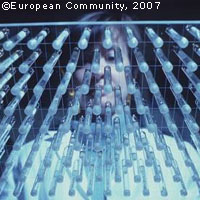Scientists identify genetic basis of restless legs syndrome
An international team of researchers has identified genes associated with restless legs syndrome (RLS), a common neurological disorder characterised by disturbed sleep and the urge to move the legs, particularly at night. Writing in the journal Nature Genetics, the scientists from Germany, Austria and Canada state that each of the genetic variants identified is associated with an increased risk of RLS of over 50%. They hope their discovery will pave the way for new treatments for the condition. RLS sufferers refer to themselves as 'nightwalkers'. During periods of rest, and particularly in the evening and at night, they experience a strong urge to move their legs and get up and walk around. This urge is often accompanied by unpleasant and even painful sensations in their legs. Movement can help to relieve these uncomfortable sensations which are often described as creeping, itching, tugging and gnawing. Patients may also move their legs involuntarily while they are asleep. As a consequence, people with RLS suffer from disturbed sleep and are often tired during the day, leading to a reduction in their quality of life. The number of symptoms and the prevalence of the condition increase with age; around 4% of people in their twenties are affected, a figure which rises to over 10% for the over sixties. Almost two thirds of all RLS patients report having family members who are also affected by the condition, leading researchers to conclude that RLS has a strong genetic component. In this latest study, scientists compared the genomes of 401 RLS patients with 1644 healthy control patients. They found three regions which were associated with an increased risk of RLS. Further studies involving additional patients and controls confirmed the results. 'For 15 years we have been searching for the cause of restless legs syndrome, have examined hundreds of patients in large studies, and today we are presenting the genes which are probably involved in RLS,' said Florian Holsboer of the Max Planck Institute for Psychiatry. The genes identified by the researchers are involved in controlling development, by switching genes on and off and setting of biochemical processes. In particular, they are involved in the development of the limbs and the nervous system. For example, the genes MEIS1 and BTBD9 control limb development. Meanwhile MAP2K5 and LBXCOR1, which are found in the same region of the genome, play an important role in the development of muscle cells and sensory pathways involved in pain and touch. However, the genetic regions identified are also active in adults; for example, in mice the protein MEIS1 regulates the production of dopamine in the brain, and so controls the movement of the organism. This provides an important pointer for the study of RLS in humans, as synthetic dopamine is often used as a treatment for RLS, although its exact mode of action remains unclear. 'The current knowledge about MEIS1, BTBD9, MAP2K5 and LBXCOR1 opens new avenues of RLS research, and the involvement of developmental genes challenges us to rethink our basic concept of this widespread disease,' the researchers write. The next challenge for the scientists is to study exactly how these genes affect RLS and why the condition tends to arise relatively late in life.
Countries
Austria, Canada, Germany



